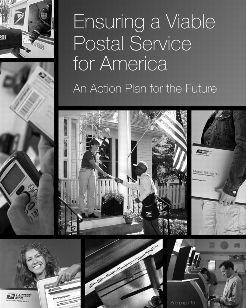For 235 years, the Postal Service has fulfilled its mission to deliver trusted, affordable service to the nation. Its business model worked well because mail volume grew steadily with the nation, and postage provided sufficient revenue to cover all operating and overhead costs. Today, the Postal Service is by far the world’s most efficient post. A U.S. First-Class Mail stamp costs 44 cents, while other major posts average 78 cents for their equivalent service. Service levels and customer satisfaction have reached the highest levels ever reported. And for six years in a row, the Postal Service has also been named the “Most Trusted Government Agency” for protecting customer privacy and rates in the Top 10 of all public and commercial entities.
Despite these accomplishments, the Postal Service’s ability to remain financially self-sufficient is in jeopardy. Mail volume has fallen nearly 20 percent in just three years, the result of the worst recession since the 1930s, which has been particularly damaging to many of the Postal Service’s largest customers, the housing, financial, and retail industries. New technologies continue to rapidly reshape how Americans communicate and transact business, further reducing volume.
The Postal Service responded with aggressive cost reductions, producing $6.0 billion savings in 2009 and another $3 billion this year. It used 75 million fewer work hours in 2010, 6.0 percent fewer than last year. However, the savings were insufficient to counter continuing declines in mail volume combined with the obligation to pay $5.5 billion to prefund future retiree health benefits and a $2.5 billion charge that resulted from discount rate and actuarial changes on the Postal Service’s workers’ compensation liability.
The Postal Service has communicated to Congress and all stakeholders that it expects current trends to continue. Without fundamental changes to its existing business model, cumulative losses could reach $238 billion by 2020. To help prevent this outcome, in March the Postal Service published Ensuring a Viable Postal Service for America, a 10-year plan that provides a conceptual framework to address its financial viability issues for the longer term. The plan was the product of more than a year of dialogue with members of Congress, the Administration, the business community, employee groups, and the general public. Supporting the effort were three consultants — Accenture, The Boston Consulting Group, and McKinsey & Company — whose analyses were incorporated in the action plan.

The plan proposes changes in two areas. First, it outlines a series of actions within management’s control — in product and service initiatives, productivity, workforce improvements, and purchasing savings. These will reduce projected net losses by a cumulative $123 billion. To eliminate the remaining $115 billion in projected losses through 2020, the plan identifies seven areas where legal changes are needed — in retiree health benefits prefunding, delivery frequency, access, workforce flexibility, pricing, product offerings, and oversight.
Since the plan was introduced in March, Congress has held several hearings and the Government Accountability Office (GAO) issued a report containing recommendations on the postal business model. Progress has been made in several public policy areas outlined in the plan, most of which is included in draft legislation sponsored by Senator Thomas Carper. Descriptions and updates of necessary legislative and regulatory changes follow:
